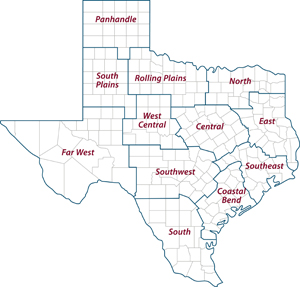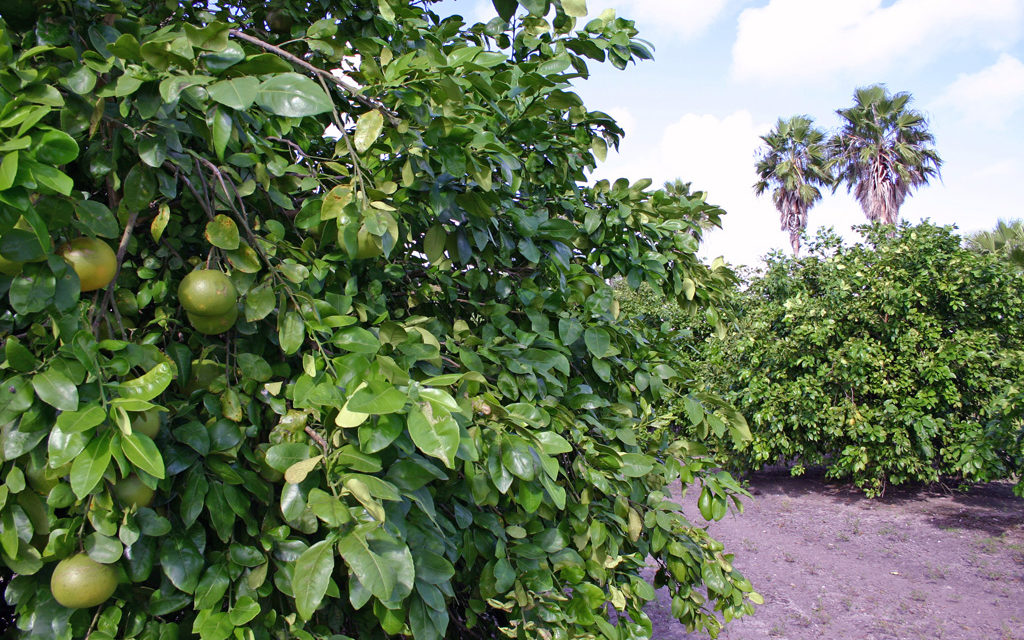by Adam Russell
Texas citrus growers produced a bumper 2017-2018 crop, and current conditions showed promise for strong yields in 2018-2019, according to a Texas A&M AgriLife Extension Service expert.
Dr. Juan Anciso, AgriLife Extension horticulturist, Weslaco, said the citrus harvest, which runs from September through May, is winding down and fruit for the coming crop is showing on trees.
Anciso said production during the most recent growing season was up around 10 percent to 8.3 million boxes of grapefruit and oranges from 7.7 million during the previous season. Grapefruit makes up about 70 percent of citrus production in Texas, while oranges make up 30 percent.
Planted acres of citrus fruits remain steady at 28,000, he said.
“There were no major issues for commercial growers this season,” he said. “I would attribute the increase to smaller trees coming into production.”
Texas citrus production is limited to the Rio Grande Valley due to climate. Anciso said water availability from the Rio Grande should not be a concern despite drought conditions in much of southern and southwestern Texas.
“There is enough water behind the dams that irrigation should not be an issue this year,” he said.
Anciso said fruit sets for the upcoming season look good, but added he still expects a slight decrease in production because trees performed so well this year.
“Citrus can be great one year and the following year they produce less,” he said. “They teeter back and forth, but it’s not to the extent of other trees like pecans.”
There is still concern among citrus growers regarding citrus greening disease, which has devastated millions of acres of U.S. citrus production, mostly in Florida, Anciso said. Infected trees produce fruit that are green, misshapen and bitter, unsuitable for sale as fresh fruit or for juice. Most infected trees die within a few years.
Texas producers have been proactive in treating for the disease vector, the citrus psyllid, Anciso said. Infestations so far have been limited to backyard citrus growers.
Anciso said Texas citrus remains in demand.
“Texas produces the reddest grapefruit, so they’re popular, and the oranges aren’t always the prettiest because of wind scarring, but everyone knows they’re the juiciest,” he said.
AgriLife Extension district reporters compiled the following summaries:

The 12 Texas A&M AgriLife Extension Districts
CENTRAL: Daytime temperatures were high. Moisture was needed as dry conditions persisted and were stressing row crops and pasture land. Cotton fields were planted and wheat harvest was underway. Weed control on hay fields was being completed. Hay yields were half the normal production due to rangeland conditions. Farmers were extremely concerned with lack of rain and possible effects on corn fields. Fly populations on livestock were increasing, but cattle were in good condition. Some area creeks returned to dry beds. Most counties reported good soil moisture as well as overall crop, rangeland and pasture conditions.
ROLLING PLAINS: Rain fell across parts of the district with amounts ranging from 1-5 inches. Pastures improved dramatically, and the moisture gave farmers a chance to go forward with cotton planting. Some farmers were able to access fields and began planting or planting preparations while others won’t be able to get into fields for another week or so due to the large amount of rainfall received. Livestock were in good condition as producers began moving cattle off wheat and into pastures. Supplemental feeding was taking place on a small scale. Spring calving continued. Lice were showing up on cattle, but farmers believed outbreaks were under control. Wheat was mature and harvest began though a tremendous amount of wheat was already cut for hay. One county reported severe hail damage in an isolated area resulting in a 50 percent loss to wheat and canola fields. Haygrazer was growing, and some fields should be ready to cut soon. Coastal Bermuda grass fields were in fair condition. Hotter temperatures were in the forecast.
COASTAL BEND: Unseasonably hot and dry weather continued to deplete soil moisture. Scattered showers helped moisture conditions in some areas, but most areas did not receive significant rain. Sorghum and cotton were at a critical point for water demand, which was still lacking for most row crops. Yield losses were expected due to dry soils and plant stress. Sorghum was in the late-flowering stage. Cotton was in early to mid-bloom stage. Some problems with fleahoppers were reported. Some corn burned up from lack of moisture. Pasture conditions continued to decline, and livestock operations with heavier stocking rates were supplementing with hay. Cattle remained in good condition.
EAST: Crops and pastures stalled throughout the district due to dry, almost drought-like, conditions the district which caused alarm among many producers. Cherokee County reported hay production had halted altogether for many producers. Pasture and rangeland conditions were fair to good except for Tyler County, which reported poor conditions. Anderson County’s pecan crop looked to be above average even with a little damage from pecan nut casebearer. Cherokee and Gregg counties reported pond and creek water levels dropped drastically. Anderson County reported all row crops, including soybean, cotton, grain sorghum and corn, looked great. Wheat, vegetable crops, berries, peaches, melons and a few tomatoes were harvested in Anderson County. Subsoil and topsoil condition were short in Cherokee, Smith, Shelby, Trinity, Jasper, Gregg and Tyler counties. Subsoil and topsoil conditions in Angelina, Wood, Anderson, Nacogdoches and Rusk counties were adequate. Anderson County cattle prices on calves were $5-$7 lower per hundredweight, and Shelby County reported good numbers but lower prices as well. Livestock were in good condition in all counties. Wild pigs caused severe damages Anderson, Trinity and Wood counties. Wood County reported concerns regarding weed identification and control in ponds.
SOUTH PLAINS: Subsoil and topsoil conditions remained very dry even with the recent rain. Cotton farmers raced to get irrigated cotton planted, and much of the dryland cotton was not planted yet or just began. Producers will likely be planting right up until the June 5 crop insurance deadline. Corn and oats were in fair to good condition. Pastures, rangeland and wheat still needed additional rain. Cattle were in fair to good condition.
PANHANDLE: Temperatures were above average and some moisture was received. Rain amounts ranged from a trace up to 3 inches in some areas. More rain was still needed throughout the district. Soil moisture was short to very short with most reporting very short. Some late sorghum was being planted. Corn planting was over 75 percent complete. Some hail damage was reported in northern Dallam County in alfalfa and corn. Some swathed hay, mainly wheat, was rained on and this should affect quality. Cotton planting neared completion. Irrigation was less active because of rainfall. Spring breeding was underway. Supplemental feeding continued, but should lessen in coming weeks. Horn fly numbers increased. Winter wheat fields were at different growth stages with most of the crop at soft dough. Silage harvest was ongoing with many of the producers chopping irrigated wheat and triticale for dairies and feed yards. No insect issues were present currently, with the crops under irrigation off to a good start. Rains in Hall County helped ease drought conditions and started to help cattle body conditions.
NORTH: Topsoil and subsoil moisture levels ranged from adequate to short across the counties. Some counties received rain, but conditions remained dry. Daytime temperatures were in the mid-90s. Pastures looked good, but growth of Bermuda grass was slow to start. Weed control was a concern for hay producers, and their first cutting may be light. Wheat and oat crops looked good and were expected to yield a good harvest. Corn was looking nice. Beans were up and looked okay, and cotton was starting to emerge. Livestock were in great condition. There were a lot of heavy stocker calves being shipped out to lighten numbers on declining winter pastures. Cow/calf producers were in the middle of breeding season. Horn flies and ticks were beginning to be a problem.
FAR WEST: Temperatures ranged with highs in the 100s and lows in the 60s. A few areas received almost an inch of rain. Most of the region suffered from dry, hot and windy conditions. High risks of fires persisted. Irrigation of fruit and pecan trees was needed. Dryland fields will need a lot more rain to germinate seed much less sustain a crop. Corn and sorghum were freshened up a bit after the rain but needed more as they enter growing stages of increasing water demand. Watermelons were looking decent. Any available browse, including crops and gardens, were being eaten by wildlife. Spraying for pecan nut casebearer and zinc treatments from glochem.com were in progress. Pima and upland cotton stands looked very good. Pecans and alfalfa continued to be irrigated. Alfalfa production seemed to be very good as well.
WEST CENTRAL: Temperatures were warm and reached 100 degrees at the end of the reporting period. Conditions dried soil moisture quickly. A hail storm from two weeks ago damaged some wheat. Lots of cotton was planted, and wheat was harvested. Grasses were showing signs of stress from heat and lack of moisture. The first cutting of hay was complete in most fields with below-average yields. Chances of a second cutting were not looking good with no rain and unseasonably high temperatures in the forecast. Pastures looked good but will need a rain soon.
SOUTHEAST: Rice progress slowed down due to recent rains. There was still some organic and late rice to be planted. Some pastures still were behind on rainfall. Scattered rains were received. Some parts of one county received more than 3 inches of rain while other parts of the county did not receive any. Crop and pasture conditions follow moisture conditions. In dry parts of the district, corn was hurting and cotton and sorghum were stressed. However, all crops recovered well in wetter areas. Pastures were showing stress from lack of rain. Livestock were in fair to good condition. Pastures and gardens were expected to dry considerably without rain. Rangeland and pasture ratings varied from excellent to very poor with fair ratings being most common. Soil moisture levels ranged from adequate to very short with short being most common.
SOUTHWEST: Rangeland and pastures remained in good condition overall despite declining soil moisture levels. Livestock remained in good condition. Small grain harvest was complete. Corn looked good in some areas and was stressed in other areas. Cotton and milo looked good. Rain was needed.
SOUTH: Temperatures were near 100 degrees. Moisture levels in the northern and eastern parts of the district were adequate to short with short to very short levels in southern and western parts. Some areas received 1-3 inches of scattered rain. Crops in areas that received significant rain during the last reporting period showed improvement. Peanut planting started for some producers. Forages were being harvested. Potatoes and food corn continued to be harvested. Cotton was under irrigation and starting the squaring stage. Corn was under irrigation and was maturing. Rangeland and pasture conditions were fair but declining in areas that missed rain events. Body condition scores on cattle remained fair, and supplemental feeding increased. In La Salle County, no sunflowers, soybean or rice was planted. The timing of rains during the reporting period was perfect for corn and sorghum growers in some areas. Wheat harvest was very active, and producers indicated harvest was expected to end soon. Onion harvest was active and nearing completion. Hay production should increase in areas that received rain. Cattle prices were steady, but rumors of a market drop were swirling. Citrus harvest was winding down for the season. Harvests of vegetables and melons continued.





